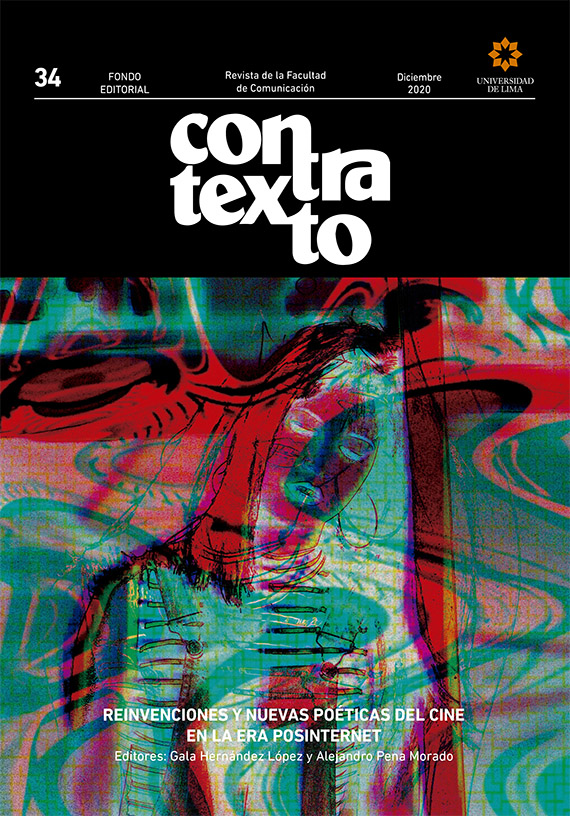The strategies of belief in Quentin Tarantino’s The Hateful Eight
DOI:
https://doi.org/10.26439/contratexto2020.n034.4875Keywords:
semiotics, narratology, belief, The Hateful Eight, Quentin TarantinoAbstract
This article proposes a semiotic-structural analysis of Quentin Tarantino's film The Hateful Eight (2015). Our work incorporates elements from filmic narratology, in particular the idea of Emily Anderson's unreliable narrator, which highlights the possibility of an overall unreliable discourse. Our analysis shows that the film, both at the level of the narrative and the discourse itself, presents a series of manipulative simulations that allow its actants to organize the cognitive dimension of knowledge and belief to their advantage. This reveals a device that not only allows characters to deceive others with their speeches, but also the enunciator which operates at a higher level. Therefore, the film transforms underreporting and misreporting into its key tools.
Downloads
References
Agamben, G. (2017). El sacramento del lenguaje. Adriana Hidalgo editora.
Agamben, G. (2019). Creación y anarquía. Adriana Hidalgo editora.
Anderson, E. (2016). Telling Stories: Unreliable Discourse, Fight Club and the Cinematic Narrator. Journal of Narrative Theory, 40(1), 80 - 107.
Blanco, D. (2012). Vigencia de la semiótica y otros ensayos. Fondo Editorial de la Universidad de Lima.
Blanco, D. (2018). Semiótica del texto fílmico. Fondo Editorial de la Universidad de Lima.
Bordwell, D. (1996). La narración en el cine de ficción. Paidós.
Branigan, E. (1992). Narrative Comprehension and Film. Routledge.
Casetti, F. (1996). El film y su espectador. Cátedra.
Courtés, J. (1997). Análisis semiótico del discurso: del enunciado a la enunciación. Gredos.
Dorra, R. (2016). Modos y grados del creer. Tópicos del Seminario, 36(2), 13-45.
Elsaesser, T. (2009). The Mind-Game Film. En W. Buckland (Ed.), Puzzle films: Complex Storytelling in Contemporary Cinema. Wiley-Blackwell.
Fabbri, P. (2001). Tácticas de los signos. Ensayos de semiótica. Gedisa.
Fontanille, J. & Zilberberg, Cl. (2004). Tensión y significación. Fondo Editorial de la Universidad de Lima.
García-Noblejas, J. J. (1983). Poética del texto audiovisual. Ediciones Universidad de Navarra.
Gaudreault, A. & Jost, F. (1995). El relato cinematográfico: cine y narratología. Paidós.
Gómez Tarín, F. (2008). Saber y mirar. Una propuesta de reformulación de los conceptos de focalización y ocularización en los discursos audiovisuales. Asociación Española de Investigación de la Comunicación.
Gómez Tarín, F. (2013). “El punto de vista en el audiovisual contemporáneo: una reformulación de conceptos enunciativos y narrativos”. En, Martha A. (Ed.), Imágenes conscientes, pp. 27 – 45.
Greimas, A. J. (1989). Del Sentido II. Ensayos semióticos. Gredos.
Greimas, A. J. y Courtés, J. (1990). Semiótica. Diccionario razonado para una teoría del lenguaje. Vol 1. Gredos.
Groys, B. (2016). Bajo sospecha. Una fenomenología de los medios. PRE-TEXTOS.
Hogan, P. (2013). Narrative Discourse. Authors and Narrators in Literature, Film, and Art. The Ohio State University Press.
Metz, C. (2002). Ensayos sobre la significación en el cine (1964 - 1968) Vol.1. Paidós.
Prósper Ribes, J. (1991). El punto de vista en la narrativa cinematográfica. Fundación Universitaria San Pablo Ceu.
Prósper Ribes, J. (2013). El sistema de continuidad: montaje y causalidad. Historia y Comunicación Social, 18, 377-386.
Stam, R., Burgoyne, R., & Flitterman-Lewis, S. (1999). Nuevos conceptos de la teoría del cine: estructuralismo, semiótica, narratología, psicoanálisis, intertextualidad. Paidós.
Tarantino, Q. (director). (2015). Los ocho más odiados [Cinta cinematográfica]. The Weinstein Company.
Downloads
Published
Issue
Section
License
All of the works published are licensed under a CC BY 4.0 Creative Commons Attribution license. (updated on March 1st 2021)
The content of the journal may be shared in any material or format. The content may be adapted, contributed upon and transformed. Both possibilities are only permitted in so far as they complete the following conditions:
- Attribution: Credit must be given where it is due, a link to the license must be provided and changes, if made, must be indicated. This should be done in the manner deemed appropriate, without suggesting that the licensor promotes you or your use of the material.
Ownership rights
The patrimonial rights for Contratexto are published under a Creative Commons BY 4.0 license, allowing authors to keep the patrimonial rights to their work without restrictions.
If a work published in Contratexto were to be copied, distributed, spread, or any other activities contemplated in the aforementioned license, the author(s) and the journal must be mentioned visibly and expressly.
Self-archive
This journal allows and encourages authors to post items submitted to the journal on personal websites or institutional repositories both prior to and after publication, while providing bibliographic details that credit, if applicable, its publication in this journal.

















